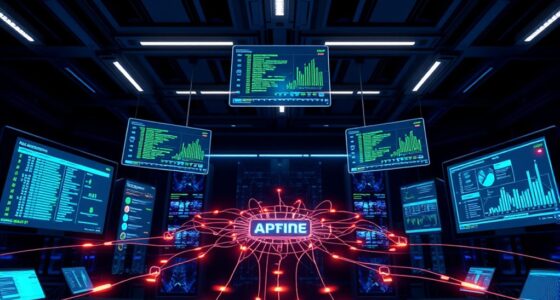As a business owner, I’ve learned that artificial intelligence (AI) is my strongest ally in the constantly changing world of cybersecurity. AI security provides real-time threat detection and mitigation to protect my valuable assets and data.
It’s a powerful shield that protects not just my business’s reputation, but also helps me stay one step ahead of evolving cyber threats. In this article, I’ll delve into the reasons why AI security is a must-have for businesses like mine.
Key Takeaways
- AI security is critical for businesses to protect sensitive information and maintain trust and credibility.
- Real-time threat detection and mitigation enable proactive protection against potential security risks.
- AI security safeguards valuable assets and data through data encryption and access control.
- Robust AI security measures help maintain a strong business reputation and rebuild trust in case of data breaches or cyber attacks.
The Growing Importance of AI Security
As a business owner, I understand the growing importance of AI security and its role in protecting my company’s valuable data. In the ever-evolving landscape of AI development, security has become a critical factor that can’t be overlooked.
With the increasing reliance on AI technologies, businesses must prioritize the protection of sensitive information to maintain trust and credibility. Ethical considerations also come into play, as AI systems can be prone to bias and misuse if not properly secured.

The importance of AI security lies not only in safeguarding data but also in ensuring fairness, transparency, and accountability in the decision-making processes of AI algorithms. By implementing robust security measures, businesses can mitigate risks, maintain integrity, and build a solid foundation for AI-driven success.
Real-Time Threat Detection and Mitigation
With real-time threat detection and mitigation, I can proactively protect my business from potential security risks. This advanced AI technology allows me to monitor my systems and networks in real-time, identifying any suspicious activities or anomalies that may indicate a security breach.
By detecting threats as they occur, I can take immediate action to mitigate the risk and prevent any potential damage or loss. This not only improves the efficiency of my security measures but also enhances the overall customer experience.
With a secure and reliable business environment, my customers can trust that their data and transactions are protected, fostering a sense of confidence and loyalty. Real-time threat detection and mitigation is an essential tool in today’s digital landscape, enabling me to stay one step ahead of potential security threats.

Protecting Valuable Assets and Data
Safeguarding valuable assets and data is paramount in today’s digital landscape, and AI security serves as a crucial ally for my business.
To protect our valuable assets and data, we rely on data encryption and access control. Data encryption ensures that our sensitive information remains secure and unreadable to unauthorized individuals. By encrypting our data, we can prevent unauthorized access and maintain the confidentiality of our valuable assets.
Additionally, access control plays a vital role in protecting our data. It allows us to grant or restrict access to specific individuals or groups, ensuring that only authorized personnel can view and modify our valuable data.
With AI security, we can confidently protect our valuable assets and data from potential threats in the ever-evolving digital world.

Safeguarding Business Reputation
To maintain a strong business reputation, AI security plays a vital role in safeguarding against potential threats and maintaining the trust of customers and stakeholders.
In today’s digital landscape, where data breaches and cyber attacks have become all too common, businesses must prioritize the protection of sensitive information. A breach can have severe consequences, including financial loss, damage to brand image, and loss of customer loyalty.
However, by implementing robust AI security measures, businesses can rebuild trust and ensure the safety of their customers’ data. AI-powered systems can detect and mitigate potential threats in real-time, preventing unauthorized access and safeguarding valuable assets.
Staying Ahead of Evolving Cyber Threats
AI security enables businesses to proactively anticipate and counteract the ever-evolving cyber threats they face. By implementing AI-powered solutions, organizations can stay ahead of these threats and protect their sensitive data from malicious actors.

Here are three key ways in which AI security helps businesses stay ahead of evolving cyber threats:
- Continuous Monitoring: AI systems can continuously monitor network traffic, user behavior, and system logs to detect any suspicious activities or anomalies. This enables businesses to promptly identify potential threats and take appropriate actions to mitigate them.
- Proactive Defense: AI security solutions use advanced algorithms to analyze vast amounts of data and identify potential vulnerabilities in real-time. By proactively identifying and patching these vulnerabilities, businesses can prevent cyber attacks before they occur.
- Threat Intelligence: AI-powered security systems leverage machine learning algorithms to gather and analyze threat intelligence from various sources. This enables businesses to stay updated on the latest attack techniques and trends, allowing them to enhance their defense strategies.
With AI security, businesses can proactively defend themselves against evolving cyber threats, ensuring the safety and integrity of their digital assets.
Frequently Asked Questions
What Are the Potential Risks and Vulnerabilities Associated With AI Security?
There are various risks and vulnerabilities associated with AI security. Identifying and mitigating these risks is crucial for protecting data and systems from potential threats. Implementing robust security measures is essential for ensuring the integrity and confidentiality of AI systems.
How Can Businesses Ensure the Privacy and Confidentiality of Their Data When Using AI Technologies?
To ensure data privacy and secure sensitive information when using AI technologies, businesses must implement robust security measures such as encryption, access controls, and regular audits. This helps protect against unauthorized access and safeguard confidential data.

Are There Any Legal or Regulatory Implications That Businesses Should Be Aware of When Implementing AI Security Measures?
When it comes to implementing AI security measures, it is crucial for businesses to be aware of the legal implications and regulatory framework. Failure to comply can result in severe consequences.
What Are the Key Steps Businesses Should Take to Effectively Respond to and Recover From Ai-Related Security Incidents?
Effective incident response and recovery planning are crucial for businesses to effectively respond to and recover from AI-related security incidents. It is necessary to have a comprehensive strategy in place to mitigate risks and minimize the impact of such incidents.
How Can Businesses Strike a Balance Between Maximizing the Benefits of AI Technologies and Minimizing the Potential Security Risks They Pose?
To strike a balance between maximizing AI benefits and minimizing security risks, businesses must carefully evaluate potential vulnerabilities, implement robust security measures, and ensure ongoing monitoring and updates to stay ahead of emerging threats.
Conclusion
In conclusion, AI security is undeniably crucial for businesses in today’s rapidly evolving cyber landscape.

One interesting statistic that highlights the importance of this is that in 2020, the average cost of a data breach for organizations worldwide was $3.86 million. This figure underscores the potential financial and reputational damage that can occur if businesses fail to prioritize AI security.
By investing in real-time threat detection and mitigation, protecting valuable assets and data, and staying ahead of evolving cyber threats, businesses can ensure their continued success and protection.











